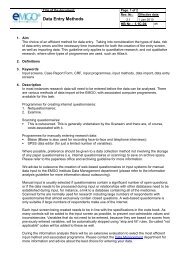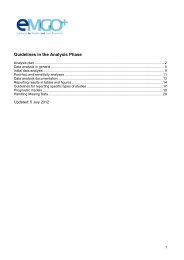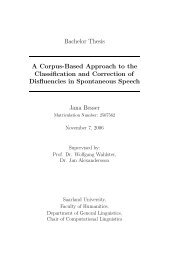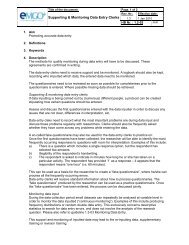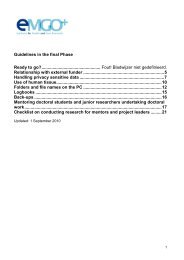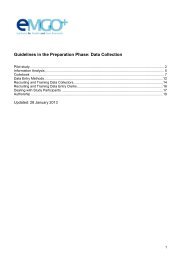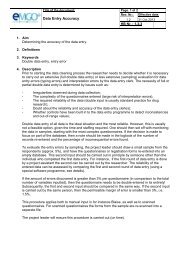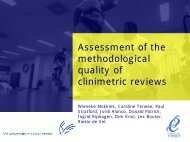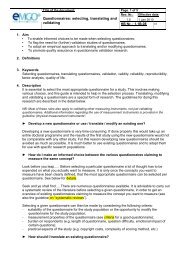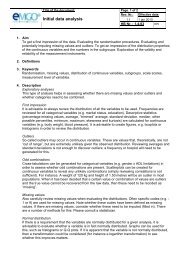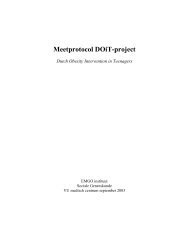Meta-analysis of Observational Studies in Epidemiology - Consort ...
Meta-analysis of Observational Studies in Epidemiology - Consort ...
Meta-analysis of Observational Studies in Epidemiology - Consort ...
You also want an ePaper? Increase the reach of your titles
YUMPU automatically turns print PDFs into web optimized ePapers that Google loves.
CONSENSUS STATEMENT<br />
<strong>Meta</strong>-<strong>analysis</strong> <strong>of</strong> <strong>Observational</strong> <strong>Studies</strong><br />
<strong>in</strong> <strong>Epidemiology</strong><br />
A Proposal for Report<strong>in</strong>g<br />
Donna F. Stroup, PhD, MSc<br />
Jesse A. Berl<strong>in</strong>, ScD<br />
Sally C. Morton, PhD<br />
Ingram Olk<strong>in</strong>, PhD<br />
G. David Williamson, PhD<br />
Drummond Rennie, MD<br />
David Moher, MSc<br />
Betsy J. Becker, PhD<br />
Theresa Ann Sipe, PhD<br />
Stephen B. Thacker, MD, MSc<br />
for the <strong>Meta</strong>-<strong>analysis</strong> Of<br />
<strong>Observational</strong> <strong>Studies</strong> <strong>in</strong><br />
<strong>Epidemiology</strong> (MOOSE) Group<br />
BECAUSE OF PRESSURE FOR TIMELY<br />
and <strong>in</strong>formed decisions <strong>in</strong> public<br />
health and medic<strong>in</strong>e and the<br />
explosion <strong>of</strong> <strong>in</strong>formation <strong>in</strong> the<br />
scientific literature, research results must<br />
be synthesized to answer urgent questions.<br />
1-4 Pr<strong>in</strong>ciples <strong>of</strong> evidence-based<br />
methods to assess the effectiveness <strong>of</strong><br />
health care <strong>in</strong>terventions and set policy<br />
are cited <strong>in</strong>creas<strong>in</strong>gly. 5 <strong>Meta</strong>-<strong>analysis</strong>, a<br />
systematic approach to identify<strong>in</strong>g, apprais<strong>in</strong>g,<br />
synthesiz<strong>in</strong>g, and (if appropriate)<br />
comb<strong>in</strong><strong>in</strong>g the results <strong>of</strong> relevant<br />
studies to arrive at conclusions about a<br />
body <strong>of</strong> research, has been applied with<br />
<strong>in</strong>creas<strong>in</strong>g frequency to randomized controlled<br />
trials (RCTs), which are considered<br />
to provide the strongest evidence<br />
regard<strong>in</strong>g an <strong>in</strong>tervention. 6,7<br />
However, <strong>in</strong> many situations randomized<br />
controlled designs are not feasible,<br />
and only data from observational<br />
Objective Because <strong>of</strong> the pressure for timely, <strong>in</strong>formed decisions <strong>in</strong> public health and<br />
cl<strong>in</strong>ical practice and the explosion <strong>of</strong> <strong>in</strong>formation <strong>in</strong> the scientific literature, research<br />
results must be synthesized. <strong>Meta</strong>-analyses are <strong>in</strong>creas<strong>in</strong>gly used to address this problem,<br />
and they <strong>of</strong>ten evaluate observational studies. A workshop was held <strong>in</strong> Atlanta,<br />
Ga, <strong>in</strong> April 1997, to exam<strong>in</strong>e the report<strong>in</strong>g <strong>of</strong> meta-analyses <strong>of</strong> observational studies<br />
and to make recommendations to aid authors, reviewers, editors, and readers.<br />
Participants Twenty-seven participants were selected by a steer<strong>in</strong>g committee, based<br />
on expertise <strong>in</strong> cl<strong>in</strong>ical practice, trials, statistics, epidemiology, social sciences, and biomedical<br />
edit<strong>in</strong>g. Deliberations <strong>of</strong> the workshop were open to other <strong>in</strong>terested scientists. Fund<strong>in</strong>g<br />
for this activity was provided by the Centers for Disease Control and Prevention.<br />
Evidence We conducted a systematic review <strong>of</strong> the published literature on the conduct<br />
and report<strong>in</strong>g <strong>of</strong> meta-analyses <strong>in</strong> observational studies us<strong>in</strong>g MEDLINE, Educational<br />
Research Information Center (ERIC), PsycLIT, and the Current Index to Statistics.<br />
We also exam<strong>in</strong>ed reference lists <strong>of</strong> the 32 studies retrieved and contacted experts <strong>in</strong><br />
the field. Participants were assigned to small-group discussions on the subjects <strong>of</strong> bias,<br />
search<strong>in</strong>g and abstract<strong>in</strong>g, heterogeneity, study categorization, and statistical methods.<br />
Consensus Process From the material presented at the workshop, the authors<br />
developed a checklist summariz<strong>in</strong>g recommendations for report<strong>in</strong>g meta-analyses <strong>of</strong> observational<br />
studies. The checklist and support<strong>in</strong>g evidence were circulated to all conference<br />
attendees and additional experts. All suggestions for revisions were addressed.<br />
Conclusions The proposed checklist conta<strong>in</strong>s specifications for report<strong>in</strong>g <strong>of</strong> metaanalyses<br />
<strong>of</strong> observational studies <strong>in</strong> epidemiology, <strong>in</strong>clud<strong>in</strong>g background, search strategy,<br />
methods, results, discussion, and conclusion. Use <strong>of</strong> the checklist should improve<br />
the usefulness <strong>of</strong> meta-analyses for authors, reviewers, editors, readers, and decision<br />
makers. An evaluation plan is suggested and research areas are explored.<br />
JAMA. 2000;283:2008-2012<br />
www.jama.com<br />
studies are available. 8 Here, we def<strong>in</strong>e an<br />
observational study as an etiologic or effectiveness<br />
study us<strong>in</strong>g data from an exist<strong>in</strong>g<br />
database, a cross-sectional study,<br />
a case series, a case-control design, a design<br />
with historical controls, or a cohort<br />
design. 9 <strong>Observational</strong> designs may<br />
lack the experimental element <strong>of</strong> a random<br />
allocation to an <strong>in</strong>tervention and<br />
rely on studies <strong>of</strong> association between<br />
changes or differences <strong>in</strong> 1 characteristic<br />
(eg, an exposure or <strong>in</strong>tervention) and<br />
changes or differences <strong>in</strong> an outcome <strong>of</strong><br />
Author Affiliations: Centers for Disease Control and<br />
Prevention, Atlanta, Ga (Drs Stroup, Williamson, and<br />
Thacker); University <strong>of</strong> Pennsylvania School <strong>of</strong> Medic<strong>in</strong>e,<br />
Philadelphia (Dr Berl<strong>in</strong>); RAND Corporation, Santa<br />
Monica (Dr Morton), University <strong>of</strong> California, San Francisco<br />
(Dr Rennie), Stanford University, Stanford (Dr<br />
Olk<strong>in</strong>), Calif; JAMA, Chicago, Ill (Dr Rennie); Thomas<br />
C. Chalmers Centre for Systematic Reviews, Children’s<br />
Hospital <strong>of</strong> Eastern Ontario Research Institute,<br />
Ottawa (Mr Moher); Michigan State University,<br />
East Lans<strong>in</strong>g (Dr Becker); and Georgia State<br />
University, Atlanta (Dr Sipe).<br />
A complete list <strong>of</strong> members <strong>of</strong> the MOOSE Group appears<br />
at the end <strong>of</strong> this article.<br />
Correspond<strong>in</strong>g Author and Repr<strong>in</strong>ts: Donna F. Stroup,<br />
PhD, MSc, Centers for Disease Control and Prevention,<br />
1600 Clifton Rd NE, Mail Stop C08, Atlanta, GA<br />
30333 (e-mail: dfs2@cdc.gov).<br />
2008 JAMA, April 19, 2000—Vol 283, No. 15 ©2000 American Medical Association. All rights reserved.
REPORTING META-ANALYSES OF OBSERVATIONAL STUDIES<br />
<strong>in</strong>terest. These designs have long been<br />
used <strong>in</strong> the evaluation <strong>of</strong> educational<br />
programs 10 and exposures that might<br />
cause disease or <strong>in</strong>jury. 11 <strong>Studies</strong> <strong>of</strong> risk<br />
factors generally cannot be randomized<br />
because they relate to <strong>in</strong>herent human<br />
characteristics or practices, and expos<strong>in</strong>g<br />
subjects to harmful risk factors<br />
is unethical. 12 At times, cl<strong>in</strong>ical data may<br />
be summarized <strong>in</strong> order to design a randomized<br />
comparison. 13 <strong>Observational</strong><br />
data may also be needed to assess the<br />
effectiveness <strong>of</strong> an <strong>in</strong>tervention <strong>in</strong> a<br />
community as opposed to the special<br />
sett<strong>in</strong>g <strong>of</strong> a controlled trial. 14 Thus, a<br />
clear understand<strong>in</strong>g <strong>of</strong> the advantages<br />
and limitations <strong>of</strong> statistical syntheses<br />
<strong>of</strong> observational data is needed. 15<br />
Although meta-<strong>analysis</strong> restricted to<br />
RCTs is usually preferred to metaanalyses<br />
<strong>of</strong> observational studies, 16-18 the<br />
number <strong>of</strong> published meta-analyses<br />
concern<strong>in</strong>g observational studies <strong>in</strong><br />
health has <strong>in</strong>creased substantially dur<strong>in</strong>g<br />
the past 4 decades (678 <strong>in</strong> 1955-<br />
1992, 525 <strong>in</strong> 1992-1995, and more than<br />
400 <strong>in</strong> 1996 alone). 19<br />
While guidel<strong>in</strong>es for meta-analyses<br />
have been proposed, many are written<br />
from the meta-analyst’s (author’s) rather<br />
than from the reviewer’s, editor’s, or<br />
reader’s perspective 20 and restrict attention<br />
to report<strong>in</strong>g <strong>of</strong> meta-analyses <strong>of</strong><br />
RCTs. 21,22 <strong>Meta</strong>-analyses <strong>of</strong> observational<br />
studies present particular challenges<br />
because <strong>of</strong> <strong>in</strong>herent biases and<br />
differences <strong>in</strong> study designs 23 ; yet, they<br />
may provide a tool for help<strong>in</strong>g to understand<br />
and quantify sources <strong>of</strong> variability<br />
<strong>in</strong> results across studies. 24<br />
We describe here the results <strong>of</strong> a<br />
workshop held <strong>in</strong> Atlanta, Ga, <strong>in</strong> April<br />
1997, to exam<strong>in</strong>e concerns regard<strong>in</strong>g the<br />
report<strong>in</strong>g <strong>of</strong> <strong>Meta</strong>-<strong>analysis</strong> Of <strong>Observational</strong><br />
<strong>Studies</strong> <strong>in</strong> <strong>Epidemiology</strong><br />
(MOOSE). This article summarizes deliberations<br />
<strong>of</strong> 27 participants (the<br />
MOOSE group) <strong>of</strong> evidence lead<strong>in</strong>g to<br />
recommendations regard<strong>in</strong>g the report<strong>in</strong>g<br />
<strong>of</strong> meta-analyses. <strong>Meta</strong>-<strong>analysis</strong> <strong>of</strong> <strong>in</strong>dividual-level<br />
data from different studies,<br />
sometimes called “pooled <strong>analysis</strong>”<br />
or “meta-<strong>analysis</strong> <strong>of</strong> <strong>in</strong>dividual patient<br />
data,” 25,26 has unique challenges that we<br />
will not address here. We propose a<br />
checklist <strong>of</strong> items for report<strong>in</strong>g that<br />
builds on similar activities for RCTs 22<br />
and is <strong>in</strong>tended for use by authors, reviewers,<br />
editors, and readers <strong>of</strong> metaanalyses<br />
<strong>of</strong> observational studies.<br />
METHODS<br />
We conducted a systematic review <strong>of</strong><br />
the published literature on the conduct<br />
and report<strong>in</strong>g <strong>of</strong> meta-analyses<br />
<strong>in</strong> observational studies. Databases<br />
searched <strong>in</strong>cluded MEDLINE, Educational<br />
Resources Information Center,<br />
PsycLIT (http://www.wesleyan.edu<br />
/libr), and the Current Index to Statistics.<br />
In addition, we exam<strong>in</strong>ed reference<br />
lists and contacted experts <strong>in</strong> the<br />
field. We used the 32 articles retrieved<br />
to generate the conference agenda and<br />
set topics <strong>of</strong> bias, search<strong>in</strong>g and abstract<strong>in</strong>g,<br />
heterogeneity, study categorization,<br />
and statistical methods. We <strong>in</strong>vited<br />
experts <strong>in</strong> meta-<strong>analysis</strong> from the<br />
fields <strong>of</strong> cl<strong>in</strong>ical practice, trials, statistics,<br />
epidemiology, social sciences, and<br />
biomedical edit<strong>in</strong>g.<br />
The workshop <strong>in</strong>cluded an overview<br />
<strong>of</strong> the quality <strong>of</strong> report<strong>in</strong>g <strong>of</strong> metaanalyses<br />
<strong>in</strong> education and the social<br />
sciences. Plenary talks were given on the<br />
topics set by the conference agenda. For<br />
each <strong>of</strong> 2 sessions, workshop participants<br />
were assigned to 1 <strong>of</strong> 5 small discussion<br />
groups, organized around the<br />
topic areas. For each group, 1 <strong>of</strong> the<br />
authors served as facilitator, and a<br />
recorder summarized po<strong>in</strong>ts <strong>of</strong> discussion<br />
for issues to be presented to all<br />
participants. Time was provided for the<br />
2 recorders and 2 facilitators for each<br />
topic to meet and prepare plenary presentations<br />
given to the entire group.<br />
We proposed a checklist for metaanalyses<br />
<strong>of</strong> observational studies based<br />
on the deliberation <strong>of</strong> the <strong>in</strong>dependent<br />
groups. F<strong>in</strong>ally, we circulated the checklist<br />
for comment to all conference attendees<br />
and representatives <strong>of</strong> several constituencies<br />
who would use the checklist.<br />
RESULTS<br />
The checklist result<strong>in</strong>g from workgroup<br />
deliberations is organized<br />
around recommendations for report<strong>in</strong>g<br />
background, search strategy,<br />
methods, results, discussion, and conclusions<br />
(TABLE).<br />
Background<br />
Report<strong>in</strong>g <strong>of</strong> the background should<br />
<strong>in</strong>clude the def<strong>in</strong>ition <strong>of</strong> the problem<br />
under study, statement <strong>of</strong> hypothesis,<br />
description <strong>of</strong> the study outcome(s)<br />
considered, type <strong>of</strong> exposure or <strong>in</strong>tervention<br />
used, type <strong>of</strong> study design used,<br />
and complete description <strong>of</strong> the study<br />
population. When comb<strong>in</strong><strong>in</strong>g observational<br />
studies, heterogeneity <strong>of</strong> populations<br />
(eg, US vs <strong>in</strong>ternational studies),<br />
design (eg, case-control vs cohort<br />
studies), and outcome (eg, different<br />
studies yield<strong>in</strong>g different relative risks<br />
that cannot be accounted for by sampl<strong>in</strong>g<br />
variation) is expected. 8<br />
Search<br />
Report<strong>in</strong>g <strong>of</strong> the search strategy should<br />
<strong>in</strong>clude qualifications <strong>of</strong> the searchers,<br />
specification <strong>of</strong> databases used,<br />
search strategy and <strong>in</strong>dex terms, use <strong>of</strong><br />
any special features (eg, “explosion”),<br />
search s<strong>of</strong>tware used, use <strong>of</strong> hand<br />
search<strong>in</strong>g and contact with authors, use<br />
<strong>of</strong> materials <strong>in</strong> languages other than English,<br />
use <strong>of</strong> unpublished material, and<br />
exclusion criteria used. Published research<br />
shows that use <strong>of</strong> electronic databases<br />
may f<strong>in</strong>d only half <strong>of</strong> all relevant<br />
studies, and contact<strong>in</strong>g authors<br />
may be useful, 27 although this result<br />
may not be true for all topic areas. 28<br />
For example, a meta-<strong>analysis</strong> <strong>of</strong> depression<br />
<strong>in</strong> elderly medical <strong>in</strong>patients 29<br />
used 2 databases for the search. In<br />
addition, bibliographies <strong>of</strong> retrieved<br />
papers were searched. However, the authors<br />
did not report their search strategy<br />
<strong>in</strong> enough detail to allow replication.<br />
An example <strong>of</strong> a thorough “reject<br />
log” can be found <strong>in</strong> the report <strong>of</strong> a meta<strong>analysis</strong><br />
<strong>of</strong> electrical and magnetic field<br />
exposure and leukemia. 30 Examples <strong>of</strong><br />
a table characteriz<strong>in</strong>g studies <strong>in</strong>cluded<br />
can be found <strong>in</strong> Franceschi et al 31 and<br />
Saag et al. 32 Complete specification <strong>of</strong><br />
search strategy is not uniform; a review<br />
<strong>of</strong> 103 published meta-analyses <strong>in</strong> education<br />
showed that search procedures<br />
were described <strong>in</strong>adequately <strong>in</strong> the majority<br />
<strong>of</strong> the articles. 10<br />
©2000 American Medical Association. All rights reserved. JAMA, April 19, 2000—Vol 283, No. 15 2009
REPORTING META-ANALYSES OF OBSERVATIONAL STUDIES<br />
Methods<br />
Items <strong>in</strong> this checklist section are concerned<br />
with the appropriateness <strong>of</strong> any<br />
quantitative summary <strong>of</strong> the data; degree<br />
to which cod<strong>in</strong>g <strong>of</strong> data from the articles<br />
was specified and objective; assessment<br />
<strong>of</strong> confound<strong>in</strong>g, study quality, and<br />
heterogeneity; use <strong>of</strong> statistical methods;<br />
and display <strong>of</strong> results. Empirical evidence<br />
shows that report<strong>in</strong>g <strong>of</strong> procedures<br />
for classification and cod<strong>in</strong>g and<br />
quality assessment is <strong>of</strong>ten <strong>in</strong>complete:<br />
fewer than half <strong>of</strong> the meta-analyses reported<br />
details <strong>of</strong> classify<strong>in</strong>g and cod<strong>in</strong>g<br />
the primary study data, and only 22% assessed<br />
quality <strong>of</strong> the primary studies. 10<br />
We recognize that the use <strong>of</strong> quality<br />
scor<strong>in</strong>g <strong>in</strong> meta-analyses <strong>of</strong> observational<br />
studies is controversial, as it is for<br />
RCTs, 16,33 because scores constructed <strong>in</strong><br />
an ad hoc fashion may lack demonstrated<br />
validity, and results may not be<br />
associated with quality. 34 Nevertheless,<br />
some particular aspects <strong>of</strong> study quality<br />
have been shown to be associated<br />
with effect: eg, adequate concealment <strong>of</strong><br />
allocation <strong>in</strong> randomized trials. 35 Thus,<br />
key components <strong>of</strong> design, rather than<br />
aggregate scores themselves, may be important.<br />
For example, <strong>in</strong> a study <strong>of</strong> bl<strong>in</strong>d<strong>in</strong>g<br />
(mask<strong>in</strong>g) <strong>of</strong> readers participat<strong>in</strong>g<br />
<strong>in</strong> meta-analyses, mask<strong>in</strong>g essentially<br />
made no difference <strong>in</strong> the summary<br />
odds ratios across the 5 meta-analyses.<br />
36 We recommend the report<strong>in</strong>g <strong>of</strong><br />
quality scor<strong>in</strong>g if it has been done and<br />
Table. A Proposed Report<strong>in</strong>g Checklist for Authors, Editors, and Reviewers <strong>of</strong> <strong>Meta</strong>-analyses<br />
<strong>of</strong> <strong>Observational</strong> <strong>Studies</strong><br />
Report<strong>in</strong>g <strong>of</strong> background should <strong>in</strong>clude<br />
Problem def<strong>in</strong>ition<br />
Hypothesis statement<br />
Description <strong>of</strong> study outcome(s)<br />
Type <strong>of</strong> exposure or <strong>in</strong>tervention used<br />
Type <strong>of</strong> study designs used<br />
Study population<br />
Report<strong>in</strong>g <strong>of</strong> search strategy should <strong>in</strong>clude<br />
Qualifications <strong>of</strong> searchers (eg, librarians and <strong>in</strong>vestigators)<br />
Search strategy, <strong>in</strong>clud<strong>in</strong>g time period <strong>in</strong>cluded <strong>in</strong> the synthesis and keywords<br />
Effort to <strong>in</strong>clude all available studies, <strong>in</strong>clud<strong>in</strong>g contact with authors<br />
Databases and registries searched<br />
Search s<strong>of</strong>tware used, name and version, <strong>in</strong>clud<strong>in</strong>g special features used (eg, explosion)<br />
Use <strong>of</strong> hand search<strong>in</strong>g (eg, reference lists <strong>of</strong> obta<strong>in</strong>ed articles)<br />
List <strong>of</strong> citations located and those excluded, <strong>in</strong>clud<strong>in</strong>g justification<br />
Method <strong>of</strong> address<strong>in</strong>g articles published <strong>in</strong> languages other than English<br />
Method <strong>of</strong> handl<strong>in</strong>g abstracts and unpublished studies<br />
Description <strong>of</strong> any contact with authors<br />
Report<strong>in</strong>g <strong>of</strong> methods should <strong>in</strong>clude<br />
Description <strong>of</strong> relevance or appropriateness <strong>of</strong> studies assembled for assess<strong>in</strong>g the hypothesis<br />
to be tested<br />
Rationale for the selection and cod<strong>in</strong>g <strong>of</strong> data (eg, sound cl<strong>in</strong>ical pr<strong>in</strong>ciples or convenience)<br />
Documentation <strong>of</strong> how data were classified and coded (eg, multiple raters, bl<strong>in</strong>d<strong>in</strong>g, and<br />
<strong>in</strong>terrater reliability)<br />
Assessment <strong>of</strong> confound<strong>in</strong>g (eg, comparability <strong>of</strong> cases and controls <strong>in</strong> studies where<br />
appropriate)<br />
Assessment <strong>of</strong> study quality, <strong>in</strong>clud<strong>in</strong>g bl<strong>in</strong>d<strong>in</strong>g <strong>of</strong> quality assessors; stratification or regression<br />
on possible predictors <strong>of</strong> study results<br />
Assessment <strong>of</strong> heterogeneity<br />
Description <strong>of</strong> statistical methods (eg, complete description <strong>of</strong> fixed or random effects models,<br />
justification <strong>of</strong> whether the chosen models account for predictors <strong>of</strong> study results,<br />
dose-response models, or cumulative meta-<strong>analysis</strong>) <strong>in</strong> sufficient detail to be replicated<br />
Provision <strong>of</strong> appropriate tables and graphics<br />
Report<strong>in</strong>g <strong>of</strong> results should <strong>in</strong>clude<br />
Graphic summariz<strong>in</strong>g <strong>in</strong>dividual study estimates and overall estimate<br />
Table giv<strong>in</strong>g descriptive <strong>in</strong>formation for each study <strong>in</strong>cluded<br />
Results <strong>of</strong> sensitivity test<strong>in</strong>g (eg, subgroup <strong>analysis</strong>)<br />
Indication <strong>of</strong> statistical uncerta<strong>in</strong>ty <strong>of</strong> f<strong>in</strong>d<strong>in</strong>gs<br />
Report<strong>in</strong>g <strong>of</strong> discussion should <strong>in</strong>clude<br />
Quantitative assessment <strong>of</strong> bias (eg, publication bias)<br />
Justification for exclusion (eg, exclusion <strong>of</strong> non–English-language citations)<br />
Assessment <strong>of</strong> quality <strong>of</strong> <strong>in</strong>cluded studies<br />
Report<strong>in</strong>g <strong>of</strong> conclusions should <strong>in</strong>clude<br />
Consideration <strong>of</strong> alternative explanations for observed results<br />
Generalization <strong>of</strong> the conclusions (ie, appropriate for the data presented and with<strong>in</strong> the doma<strong>in</strong><br />
<strong>of</strong> the literature review)<br />
Guidel<strong>in</strong>es for future research<br />
Disclosure <strong>of</strong> fund<strong>in</strong>g source<br />
also recommend subgroup or sensitivity<br />
<strong>analysis</strong> rather than us<strong>in</strong>g quality<br />
scores as weights <strong>in</strong> the <strong>analysis</strong>. 37,38<br />
While some control over heterogeneity<br />
<strong>of</strong> design may be accomplished<br />
through the use <strong>of</strong> exclusion rules, we<br />
recommend us<strong>in</strong>g broad <strong>in</strong>clusion criteria<br />
for studies, and then perform<strong>in</strong>g<br />
analyses relat<strong>in</strong>g design features to outcome.<br />
8 In cases when heterogeneity <strong>of</strong><br />
outcomes is particularly problematic,<br />
a s<strong>in</strong>gle summary measure may well be<br />
<strong>in</strong>appropriate. 39 Analyses that stratify<br />
by study feature or regression <strong>analysis</strong><br />
with design features as predictors can<br />
be useful <strong>in</strong> assess<strong>in</strong>g whether study<br />
outcomes <strong>in</strong>deed vary systematically<br />
with these features. 40<br />
Investigat<strong>in</strong>g heterogeneity was a key<br />
feature <strong>of</strong> a meta-<strong>analysis</strong> <strong>of</strong> observational<br />
studies <strong>of</strong> asbestos exposure and<br />
risk <strong>of</strong> gastro<strong>in</strong>test<strong>in</strong>al cancer. 41 The authors<br />
<strong>of</strong> the meta-<strong>analysis</strong> hypothesized<br />
that studies allow<strong>in</strong>g for a latent<br />
period between the <strong>in</strong>itiation <strong>of</strong> exposure<br />
and any <strong>in</strong>creases <strong>in</strong> risk should<br />
show, on average, appropriately higher<br />
standardized mortality ratios than studies<br />
that ignored latency. In other words,<br />
the apparent effect <strong>of</strong> exposure would<br />
be attenuated by <strong>in</strong>clud<strong>in</strong>g the latent<br />
period <strong>in</strong> the calculation <strong>of</strong> time at risk<br />
(the “denom<strong>in</strong>ator”), s<strong>in</strong>ce exposurerelated<br />
deaths (the “numerator”) would,<br />
by def<strong>in</strong>ition, not occur dur<strong>in</strong>g that latent<br />
period (FIGURE).<br />
In fact, the data suggested that studies<br />
allow<strong>in</strong>g for latent periods found<br />
on average somewhat higher standardized<br />
mortality ratios than studies<br />
ignor<strong>in</strong>g latency. This example shows<br />
that sources <strong>of</strong> bias and heterogeneity<br />
can be hypothesized prior to <strong>analysis</strong><br />
and subsequently confirmed by the<br />
<strong>analysis</strong>.<br />
Results<br />
Recommendations for report<strong>in</strong>g <strong>of</strong> results<br />
<strong>in</strong>clude graphical summaries <strong>of</strong><br />
study estimates and any comb<strong>in</strong>ed estimate,<br />
a table list<strong>in</strong>g descriptive <strong>in</strong>formation<br />
for each study, results <strong>of</strong> sensitivity<br />
test<strong>in</strong>g and any subgroup<br />
<strong>analysis</strong>, and an <strong>in</strong>dication <strong>of</strong> statistical<br />
uncerta<strong>in</strong>ty <strong>of</strong> f<strong>in</strong>d<strong>in</strong>gs.<br />
2010 JAMA, April 19, 2000—Vol 283, No. 15 ©2000 American Medical Association. All rights reserved.
REPORTING META-ANALYSES OF OBSERVATIONAL STUDIES<br />
Discussion<br />
The discussion should <strong>in</strong>clude issues related<br />
to bias, <strong>in</strong>clud<strong>in</strong>g publication bias,<br />
confound<strong>in</strong>g, and quality. Bias can occur<br />
<strong>in</strong> the orig<strong>in</strong>al studies (result<strong>in</strong>g from<br />
flaws <strong>in</strong> the study design that tend to distort<br />
the magnitude or direction <strong>of</strong> associations<br />
<strong>in</strong> the data) or from the way <strong>in</strong><br />
which studies are selected for <strong>in</strong>clusion.<br />
42 Publication bias, the selective<br />
publication <strong>of</strong> studies based on the magnitude<br />
(usually larger) and direction <strong>of</strong><br />
their f<strong>in</strong>d<strong>in</strong>gs, represents a particular<br />
threat to the validity <strong>of</strong> meta-<strong>analysis</strong> <strong>of</strong><br />
observational studies. 43-45 Thorough<br />
specifications <strong>of</strong> quality assessment can<br />
contribute to understand<strong>in</strong>g some <strong>of</strong> the<br />
variations <strong>in</strong> the observational studies<br />
themselves. Methods should be used to<br />
aid <strong>in</strong> the detection <strong>of</strong> publication bias,<br />
eg, fail-safe procedures or funnel plots. 46<br />
Schlesselman 47 comments on such biases<br />
<strong>in</strong> assess<strong>in</strong>g the possible association<br />
between endometrial cancer and<br />
oral contraceptives. This meta-<strong>analysis</strong><br />
comb<strong>in</strong>ed both cohort and casecontrol<br />
studies and used a sensitivity<br />
<strong>analysis</strong> to illustrate the <strong>in</strong>fluence <strong>of</strong><br />
specific studies, such as those published<br />
<strong>in</strong> English.<br />
Conclusion<br />
Due to these biases <strong>in</strong> observational<br />
studies, the conclusion <strong>of</strong> the report<br />
should conta<strong>in</strong> consideration <strong>of</strong> alternative<br />
explanations for observed results<br />
and appropriate generalizations <strong>of</strong><br />
the conclusion. A carefully conducted<br />
meta-<strong>analysis</strong> can reveal areas warrant<strong>in</strong>g<br />
further research. F<strong>in</strong>ally, s<strong>in</strong>ce fund<strong>in</strong>g<br />
source has been shown to be an important<br />
source <strong>of</strong> heterogeneity, 48 the<br />
sponsor<strong>in</strong>g organization should be disclosed<br />
and any effect on <strong>analysis</strong> should<br />
be exam<strong>in</strong>ed.<br />
COMMENT<br />
Tak<strong>in</strong>g stock <strong>of</strong> what is known <strong>in</strong> any<br />
field <strong>in</strong>volves review<strong>in</strong>g the exist<strong>in</strong>g literature,<br />
summariz<strong>in</strong>g it <strong>in</strong> appropriate<br />
ways, and explor<strong>in</strong>g the implications<br />
<strong>of</strong> heterogeneity <strong>of</strong> population and<br />
study for heterogeneity <strong>of</strong> study results.<br />
<strong>Meta</strong>-<strong>analysis</strong> provides a systematic<br />
way <strong>of</strong> perform<strong>in</strong>g this research<br />
Figure. Effect <strong>of</strong> Latent Period on<br />
Heterogeneity<br />
Exposure-Related Deaths<br />
Do Not Occur<br />
Start <strong>of</strong><br />
Exposure<br />
Latent Period<br />
At-Risk Period Beg<strong>in</strong>s<br />
Time<br />
Time-at-Risk<br />
Exposure-Related<br />
Deaths Occur<br />
synthesis, while <strong>in</strong>dicat<strong>in</strong>g when more<br />
research is necessary.<br />
The application <strong>of</strong> formal metaanalytic<br />
methods to observational studies<br />
has been controversial. 42 One reason<br />
for this has been that potential biases <strong>in</strong><br />
the orig<strong>in</strong>al studies, relative to the biases<br />
<strong>in</strong> RCTs, make the calculation <strong>of</strong> a s<strong>in</strong>gle<br />
summary estimate <strong>of</strong> effect <strong>of</strong> exposure<br />
potentially mislead<strong>in</strong>g. Similarly, the<br />
extreme diversity <strong>of</strong> study designs and<br />
populations <strong>in</strong> epidemiology makes the<br />
<strong>in</strong>terpretation <strong>of</strong> simple summaries problematic,<br />
at best. In addition, methodologic<br />
issues related specifically to meta<strong>analysis</strong>,<br />
such as publication bias, could<br />
have particular impact when comb<strong>in</strong><strong>in</strong>g<br />
results <strong>of</strong> observational studies. 44,47<br />
Despite these challenges, metaanalyses<br />
<strong>of</strong> observational studies cont<strong>in</strong>ue<br />
to be one <strong>of</strong> the few methods for<br />
assess<strong>in</strong>g efficacy and effectiveness and<br />
are be<strong>in</strong>g published <strong>in</strong> <strong>in</strong>creas<strong>in</strong>g numbers.<br />
Our goal is to improve the report<strong>in</strong>g<br />
<strong>of</strong> these meta-analyses so that readers<br />
can understand what was done <strong>in</strong> a<br />
given <strong>analysis</strong>, who did it, and why it was<br />
done. If bias is a problem, we suggest that<br />
an <strong>in</strong>formative approach is to use broad<br />
<strong>in</strong>clusion criteria for studies and then to<br />
perform analyses (when the data permit)<br />
relat<strong>in</strong>g suspected sources <strong>of</strong> bias<br />
and variability to study f<strong>in</strong>d<strong>in</strong>gs.<br />
Methodologic and <strong>in</strong>terpretational<br />
concerns make the clear and thorough<br />
report<strong>in</strong>g <strong>of</strong> meta-analyses <strong>of</strong> observational<br />
studies absolutely essential. Our<br />
workshop was convened to address the<br />
problem <strong>of</strong> <strong>in</strong>creas<strong>in</strong>g diversity and variability<br />
that exist <strong>in</strong> report<strong>in</strong>g metaanalyses<br />
<strong>of</strong> observational studies. In<br />
construct<strong>in</strong>g the checklist, we have<br />
attempted, where possible, to provide<br />
references to literature justify<strong>in</strong>g the<br />
<strong>in</strong>clusion <strong>of</strong> particular items.<br />
Assessment <strong>of</strong> the usefulness <strong>of</strong> recommendations<br />
for report<strong>in</strong>g is dependent<br />
on a well-designed and effectively<br />
conducted evaluation. The<br />
workshop participants proposed a<br />
3-pronged approach to determ<strong>in</strong>e usefulness<br />
and implementation <strong>of</strong> these<br />
recommendations.<br />
First, further comments should be <strong>in</strong>corporated<br />
<strong>in</strong>to revisions <strong>of</strong> the checklist,<br />
to ensure its usefulness to journal<br />
reviewers and editors. The US Food and<br />
Drug Adm<strong>in</strong>istration (FDA) receives<br />
and reviews petitions and applications<br />
for approval <strong>of</strong> regulated products<br />
and/or their label<strong>in</strong>g. The FDA’s<br />
Center for Food Safety and Applied Nutrition<br />
is now receiv<strong>in</strong>g applications that<br />
use results <strong>of</strong> meta-analyses <strong>in</strong> support<br />
<strong>of</strong> the requested action. The revised<br />
checklist should be tested dur<strong>in</strong>g<br />
the review <strong>of</strong> an application. One<br />
might randomly assign FDA reviewers<br />
who encounter systematic reviews<br />
<strong>of</strong> observational studies to use the<br />
checklist or not. S<strong>in</strong>ce the requirements<br />
for report<strong>in</strong>g for regulatory purposes<br />
might not completely co<strong>in</strong>cide<br />
with those <strong>in</strong> the checklist and s<strong>in</strong>ce<br />
sample size (the number <strong>of</strong> formal systematic<br />
reviews received by the FDA)<br />
might be small, this evaluation should<br />
document any potential <strong>in</strong>compatibility<br />
between requirements for regulatory<br />
report<strong>in</strong>g and the checklist.<br />
Second, we will work with the Cochrane<br />
Collaboration to promote the use<br />
<strong>of</strong> these recommendations by Cochrane<br />
collaborative review groups. 49<br />
Members <strong>of</strong> the Cochrane Collaboration<br />
are <strong>in</strong>volved rout<strong>in</strong>ely <strong>in</strong> perform<strong>in</strong>g<br />
systematic reviews. Some are now<br />
<strong>in</strong>corporat<strong>in</strong>g nonrandomized studies<br />
out <strong>of</strong> necessity. A trial <strong>of</strong> use <strong>of</strong> the<br />
checklist could be compared with the<br />
FDA experience.<br />
Third, an evaluation <strong>of</strong> the checklist<br />
by authors, reviewers, readers, and<br />
editors could compare objective measures<br />
<strong>of</strong> the quality <strong>of</strong> articles written<br />
with and without the formal use <strong>of</strong> the<br />
guidel<strong>in</strong>es. A challenge to the use <strong>of</strong><br />
quality measures would be arriv<strong>in</strong>g at<br />
a valid measure <strong>of</strong> quality. A more important<br />
end po<strong>in</strong>t for trials <strong>in</strong> journals<br />
©2000 American Medical Association. All rights reserved. JAMA, April 19, 2000—Vol 283, No. 15 2011
REPORTING META-ANALYSES OF OBSERVATIONAL STUDIES<br />
is process measures. Questions <strong>of</strong> <strong>in</strong>terest<br />
<strong>in</strong>clude whether the use <strong>of</strong> the<br />
checklist makes preparation and evaluation<br />
<strong>of</strong> manuscripts easier or is otherwise<br />
helpful. Aga<strong>in</strong>, def<strong>in</strong><strong>in</strong>g the<br />
constructs <strong>of</strong> <strong>in</strong>terest present crucial<br />
challenges to this research.<br />
Less formal evaluations, based on<br />
comments from users <strong>in</strong> any <strong>of</strong> the<br />
above groups, would certa<strong>in</strong>ly be helpful,<br />
as well. One would need to be concerned<br />
about contam<strong>in</strong>ation <strong>of</strong> the<br />
control groups when evaluat<strong>in</strong>g the<br />
checklist, as journals, for example,<br />
might adopt the checklist even <strong>in</strong> the<br />
absence <strong>of</strong> evidence <strong>of</strong> its efficacy from<br />
randomized trials.<br />
In conclusion, the conference participants<br />
noted that meta-analyses are themselves<br />
observational studies, even when<br />
applied to RCTs. 50 If a role for metaanalyses<br />
<strong>of</strong> observational studies <strong>in</strong> sett<strong>in</strong>g<br />
policy is to be achieved, 51 standards<br />
<strong>of</strong> report<strong>in</strong>g must be ma<strong>in</strong>ta<strong>in</strong>ed<br />
to allow proper evaluation <strong>of</strong> the quality<br />
and completeness <strong>of</strong> meta-analyses.<br />
The <strong>Meta</strong>-<strong>analysis</strong> Of <strong>Observational</strong> <strong>Studies</strong> <strong>in</strong> <strong>Epidemiology</strong><br />
(MOOSE) Group: Centers for Disease Control<br />
and Prevention, Atlanta, Ga: Gary Jeng, PhD, Rob<br />
Lyerla, PhD, Thomas Peterman, MD, Donna F. Stroup,<br />
PhD, MSc, Stephen B. Thacker, MD, MSc, and G. David<br />
Williamson, PhD; University <strong>of</strong> Pennsylvania School<br />
<strong>of</strong> Medic<strong>in</strong>e, Philadelphia: Jesse A. Berl<strong>in</strong>, ScD; RAND<br />
Corporation, Santa Monica, Calif: Sally C. Morton, PhD;<br />
Stanford University, Stanford, Calif: Ingram Olk<strong>in</strong>, PhD;<br />
University <strong>of</strong> California, San Francisco, and JAMA, Chicago,<br />
Ill: Drummond Rennie, MD; Thomas C. Chalmers<br />
Centre for Systematic Reviews, Children’s Hospital<br />
<strong>of</strong> Eastern Ontario Research Institute, Ottawa:<br />
David Moher, MSc; Michigan State University, East<br />
Lans<strong>in</strong>g: Betsy J. Becker, PhD; Georgia State University,<br />
Atlanta: Theresa Ann Sipe, PhD; Centre for Statistics<br />
<strong>in</strong> Medic<strong>in</strong>e, Oxford, England: Douglas Altman,<br />
PhD; Memorial Sloan-Ketter<strong>in</strong>g Cancer Center,<br />
New York, NY: Col<strong>in</strong> Begg, PhD; Hamilton Wentworth<br />
Regional Public Health Department, Hamilton,<br />
Ontario: Larry Chambers, PhD; Harvard Medical<br />
School and Brigham and Women’s Hospital, Boston,<br />
Mass: Graham Colditz, PhD; University <strong>of</strong> Maryland,<br />
Baltimore: Kay Dickers<strong>in</strong>, PhD; AT&T Labs, Murray Hill,<br />
NJ: William DuMouchel, PhD; University <strong>of</strong> Colorado,<br />
Denver: Karen Kafadar, PhD; Cleveland, Ohio:<br />
Tom Lang, MA; Food and Drug Adm<strong>in</strong>istration, Wash<strong>in</strong>gton,<br />
DC: Lynn Larsen, PhD; University <strong>of</strong> M<strong>in</strong>nesota,<br />
M<strong>in</strong>neapolis: Thomas A. Louis, PhD; University<br />
<strong>of</strong> British Columbia, Vancouver: Parm<strong>in</strong>der Ra<strong>in</strong>a, PhD;<br />
University <strong>of</strong> Pittsburgh, Pittsburgh, Pa: Allan Sampson,<br />
PhD; Family Health International, Research Triangle<br />
Park, NC: Ken Schulz, PhD, MSc; and Institute<br />
<strong>of</strong> Medic<strong>in</strong>e, Wash<strong>in</strong>gton, DC: Mike Stoto, PhD.<br />
Acknowledgment: We thank Susan Eastwood, MA,<br />
University <strong>of</strong> California, San Francisco; Christ<strong>in</strong>e<br />
Friedenreich, PhD, Alberta Cancer Board and University<br />
<strong>of</strong> Calgary, Calgary; Sander Greenland, DrPH, Cstat,<br />
MA, MS, University <strong>of</strong> California, Los Angeles; Richard<br />
Horton, MBBCh, MD, Lancet, London, England;<br />
Diana Petitti, MD, MPH, Southern California Kaiser<br />
Permanente Medical Care Program, Pasadena; Duncan<br />
Saunders, MBBCh, PhD, University <strong>of</strong> Alberta, Edmonton;<br />
and Stephen D. Walter, PhD, McMaster University,<br />
Hamilton, Ontario, for their advice and<br />
substantive comments on an earlier draft <strong>of</strong> this article.<br />
In addition, we thank Barbara McDonnell, CDC, for<br />
manag<strong>in</strong>g complex logistics <strong>of</strong> this project.<br />
REFERENCES<br />
1. Greenland S. Quantitative methods <strong>in</strong> the review <strong>of</strong><br />
epidemiologic literature. Epidemiol Rev. 1987;9:1-30.<br />
2. Chalmers TC, Lau J. <strong>Meta</strong>-analytic stimulus for<br />
changes <strong>in</strong> cl<strong>in</strong>ical trials. Stat Methods Med Res. 1993;<br />
2:161-172.<br />
3. Badgett RG, O’Keefe M, Henderson MC. Us<strong>in</strong>g systematic<br />
reviews <strong>in</strong> cl<strong>in</strong>ical education. Ann Intern Med.<br />
1997;126:886-891.<br />
4. Ohlsson A. Systematic reviews. Scand J Cl<strong>in</strong> Lab<br />
Invest Suppl. 1994;219:25-32.<br />
5. Bero LA, Jadad AR. How consumers and policymakers<br />
can use systematic reviews for decision mak<strong>in</strong>g.<br />
Ann Intern Med. 1997;127:37-42.<br />
6. Thacker SB. <strong>Meta</strong>-<strong>analysis</strong>. JAMA. 1988;259:1685-<br />
1689.<br />
7. Petitti D. <strong>Meta</strong>-Analysis, Decision Analysis, and<br />
Cost Effectiveness Analysis. New York, NY: Oxford<br />
University Press; 1994.<br />
8. Berl<strong>in</strong> JA. Invited commentary. Am J Epidemiol.<br />
1995;142:383-387.<br />
9. Peipert JF, Phipps MG. <strong>Observational</strong> studies. Cl<strong>in</strong><br />
Obstet Gynecol. 1998;41:235-244.<br />
10. Sipe TA, Curlette WL. A meta-synthesis <strong>of</strong> factors<br />
related to educational achievement. Int J Educ Res.<br />
1997;25:583-598.<br />
11. Ioannidis JP, Lau J. Pool<strong>in</strong>g research results. Jt<br />
Comm J Qual Improv. 1999;25:462-469.<br />
12. Lipsett M, Campleman S. Occupational exposure<br />
to diesel exhaust and lung cancer: a meta<strong>analysis</strong>.<br />
Am J Public Health. 1999;89:1009-1017.<br />
13. Vickers A, Cassileth B, Ernst E, et al. How should<br />
we research unconventional therapies? Int J Technol<br />
Assess Health Care. 1997;13:111-121.<br />
14. Mann CC. Can meta-<strong>analysis</strong> make policy? Science.<br />
1999;266:960-962.<br />
15. Blettner M, Sauerbrei W, Schleh<strong>of</strong>er B, et al. Traditional<br />
reviews, meta-analyses and pooled analyses<br />
<strong>in</strong> epidemiology. Int J Epidemiol. 1999;28:1-9.<br />
16. Greenland S. Invited commentary. Am J Epidemiol.<br />
1994;140:290-296.<br />
17. Lau J, Ioannidis JP, Schmid CH. Summ<strong>in</strong>g up evidence.<br />
Lancet. 1998;351:123-127.<br />
18. Shapiro S. <strong>Meta</strong>-<strong>analysis</strong>/shmeta-<strong>analysis</strong>. Am J<br />
Epidemiol. 1994;140:771-778.<br />
19. Stroup DF, Thacker SB, Olson CM, Glass RM.<br />
Characteristics <strong>of</strong> meta-analyses submitted to a medical<br />
journal. From: International Congress on Biomedical<br />
Peer Review and Global Communications; September<br />
17-21, 1997; Prague, Czech Republic.<br />
20. Lang TA, Secic M. How to Report Statistics <strong>in</strong><br />
Medic<strong>in</strong>e. Philadelphia, Pa: American College <strong>of</strong> Physicians;<br />
1997.<br />
21. Cook DJ, Sackett DL, Spitzer WO. Methodologic<br />
guidel<strong>in</strong>es for systematic reviews <strong>of</strong> randomized<br />
control trials <strong>in</strong> health care from the Potsdam consultation<br />
on meta-<strong>analysis</strong>. J Cl<strong>in</strong> Epidemiol. 1995;<br />
48:167-171.<br />
22. Moher D, Cook DJ, Eastwood S, et al. Improv<strong>in</strong>g<br />
the quality <strong>of</strong> reports <strong>of</strong> meta-analyses <strong>of</strong> randomised<br />
controlled trials. Lancet. 1999;354:1896-1900.<br />
23. Huston P. Health services research. CMAJ. 1996;<br />
155:1697-1702.<br />
24. Egger M, Scheider M, Davey-Smith G. <strong>Meta</strong><strong>analysis</strong>.<br />
BMJ. 1998;316:140-144.<br />
25. Stewart LA, Parmar MK. <strong>Meta</strong>-<strong>analysis</strong> <strong>of</strong> the literature<br />
or <strong>of</strong> <strong>in</strong>dividual patient data? Lancet. 1993;<br />
341:418-422.<br />
26. Ste<strong>in</strong>berg K, Smith SF, Lee N, et al. Comparison<br />
<strong>of</strong> effect estimates from a meta-<strong>analysis</strong> <strong>of</strong> summary<br />
data from published studies and from a meta<strong>analysis</strong><br />
us<strong>in</strong>g <strong>in</strong>dividual patient data for ovarian cancer<br />
studies. Am J Epidemiol. 1997;145:1917-1925.<br />
27. McManus RJ, Wilson S, Delaney BC, et al. Review<br />
<strong>of</strong> the usefulness <strong>of</strong> contact<strong>in</strong>g other experts when<br />
conduct<strong>in</strong>g a literature search for systematic reviews.<br />
BMJ. 1998;317:1562-1563.<br />
28. Hether<strong>in</strong>gton J, Dickers<strong>in</strong> K, Chalmers I, Me<strong>in</strong>ert<br />
CL. Retrospective and prospective identification <strong>of</strong> unpublished<br />
controlled trials.Pediatrics. 1989;84:374-380.<br />
29. Cole MG, Bellavance F. Depression <strong>in</strong> elderly medical<br />
<strong>in</strong>patients. CMAJ. 1997;157:1055-1060.<br />
30. Kheifets LI, Afifi AA, Buffler PA, et al. Occupational<br />
electric and magnetic field exposure and leukemia.<br />
J Occup Environ Med. 1997;39:1074-1091.<br />
31. Franceschi S, La Vecchia C, Talam<strong>in</strong>i R. Oral contraceptives<br />
and cervical neoplasia. Tumori. 1986;72:<br />
21-30.<br />
32. Saag KG, Criswell LA, Sems KM, et al. Low-dose<br />
corticosteroids <strong>in</strong> rheumatoid arthritis. Arthritis Rheum.<br />
1996;39:1818-1825.<br />
33. Emerson JD, Burdick E, Hoagl<strong>in</strong> DC, et al. An empirical<br />
study <strong>of</strong> the possible relation <strong>of</strong> treatment differences<br />
to quality scores <strong>in</strong> controlled randomized cl<strong>in</strong>ical<br />
trials. Control Cl<strong>in</strong> Trials. 1990;11:339-352.<br />
34. Jüni P, Witschi A, Bloch R, Egger M. The hazards<br />
<strong>of</strong> scor<strong>in</strong>g the quality <strong>of</strong> cl<strong>in</strong>ical trials for meta<strong>analysis</strong>.<br />
JAMA. 1999;282:1054-1060.<br />
35. Schulz KF, Chalmers I, Hayes RJ, Altman DG. Empirical<br />
evidence <strong>of</strong> bias. JAMA. 1995;273:408-412.<br />
36. Berl<strong>in</strong> JA, for the University <strong>of</strong> Pennsylvania <strong>Meta</strong><strong>analysis</strong><br />
Bl<strong>in</strong>d<strong>in</strong>g Study Group. Does bl<strong>in</strong>d<strong>in</strong>g <strong>of</strong> readers<br />
affect the results <strong>of</strong> meta-analyses? Lancet. 1997;<br />
350:185-186.<br />
37. Hasselblad V, Eddy DM, Kotchmar DJ. Synthesis<br />
<strong>of</strong> environmental evidence. J Air Waste Manag Assoc.<br />
1992;42:662-671.<br />
38. Friedenreich CM, Brant RF, Riboli E. Influence <strong>of</strong><br />
methodologic factors <strong>in</strong> a pooled <strong>analysis</strong> <strong>of</strong> 13 casecontrol<br />
studies <strong>of</strong> colorectal cancer and dietary fiber.<br />
<strong>Epidemiology</strong>. 1994;5:66-67.<br />
39. Berl<strong>in</strong> JA, Rennie D. Measur<strong>in</strong>g the quality <strong>of</strong> trials.<br />
JAMA. 1999;282:1083-1085.<br />
40. Colditz GA, Burdick E, Mosteller F. Heterogeneity<br />
<strong>in</strong> meta-<strong>analysis</strong> <strong>of</strong> data from epidemiologic studies.<br />
Am J Epidemiol. 1995;142:371-382.<br />
41. Frumk<strong>in</strong> H, Berl<strong>in</strong> J. Asbestos exposure and gastro<strong>in</strong>test<strong>in</strong>al<br />
malignancy review and meta-<strong>analysis</strong><br />
[published correction appears <strong>in</strong> Am J Ind Med. 1988;<br />
14:493]. Am J Ind Med. 1988;14:79-95.<br />
42. Blettner M, Sauerbrei W, Schleh<strong>of</strong>er B, et al. Traditional<br />
reviews, meta-analyses and pooled analyses<br />
<strong>in</strong> epidemiology. Int J Epidemiol. 1999;28:1-9.<br />
43. Rosenthal R. The file drawer problem and tolerance<br />
for null results. Psychol Bull. 1979;86:638-641.<br />
44. Easterbrook PJ, Berl<strong>in</strong> JA, Gopalan R, Matthews<br />
DR. Publication bias <strong>in</strong> cl<strong>in</strong>ical research. Lancet. 1991;<br />
337:867-872.<br />
45. Dickers<strong>in</strong> K, M<strong>in</strong> YI. NIH cl<strong>in</strong>ical trials and publication<br />
bias. Onl<strong>in</strong>e J Curr Cl<strong>in</strong> Trials [serial onl<strong>in</strong>e].<br />
1993 Apr 28: Doc No 50.<br />
46. Hedges LV, Olk<strong>in</strong> I. Statistical Methods for <strong>Meta</strong><strong>analysis</strong>.<br />
Boston, Mass: Academic Press; 1985.<br />
47. Schlesselman JJ. Risk <strong>of</strong> endometrial cancer <strong>in</strong> relation<br />
to use <strong>of</strong> comb<strong>in</strong>ed oral contraceptives. Hum<br />
Reprod. 1997;12:1851-1863.<br />
48. Jadad A, Sullivan C, Luo D, et al. Patients’ preferences<br />
for Turbuhaler or pressurized metered dose<br />
<strong>in</strong>halers (pMDIs) <strong>in</strong> the treatment. From Annual Meet<strong>in</strong>g<br />
<strong>of</strong> the American Academy <strong>of</strong> Allergy, Asthma, and<br />
Immunology; March 3-8, 2000; San Diego, Calif.<br />
49. Huston P. Cochrane Collaboration help<strong>in</strong>g unravel<br />
tangled web woven by <strong>in</strong>ternational research.<br />
CMAJ. 1996;154:1389-1392.<br />
50. Moher D, Pham B, Jones A, et al. Does the quality<br />
<strong>of</strong> reports <strong>of</strong> randomised trials affect estimates <strong>of</strong><br />
<strong>in</strong>tervention efficacy reported <strong>in</strong> meta-analyses? Lancet.<br />
1998;352:609-613.<br />
51. Berl<strong>in</strong> JA, Colditz GA. The role <strong>of</strong> meta-<strong>analysis</strong><br />
<strong>in</strong> the regulatory process for foods, drugs, and devices.<br />
JAMA. 1999;281:830-834.<br />
2012 JAMA, April 19, 2000—Vol 283, No. 15 ©2000 American Medical Association. All rights reserved.



